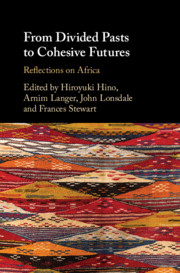Book contents
- From Divided Pasts to Cohesive Futures
- From Divided Pasts to Cohesive Futures
- Copyright page
- Contents
- Figures
- Tables
- Contributors
- Foreword
- Acknowledgments
- Introduction: Understanding Processes of Change in Social Cohesion: Learning from Comparative History
- Part I Social Cohesion in Africa: Case Studies of Past and Present
- Part II Policies and Institutions for Social Cohesion
- 6 Redressing Inequalities in Societies
- 7 Vertical and Horizontal Decentralisation for Equity and Stability
- 8 Land Reform
- 9 Protecting Education from Ethnic Politics
- 10 Building Social Cohesion through Education in Africa? Lessons from Côte d’Ivoire and Kenya
- 11 Remaking Cape Town
- 12 Key Ingredients of Inclusive Politics
- Part III Conclusions and Policy Recommendations
- Index
- References
10 - Building Social Cohesion through Education in Africa? Lessons from Côte d’Ivoire and Kenya
from Part II - Policies and Institutions for Social Cohesion
Published online by Cambridge University Press: 05 August 2019
- From Divided Pasts to Cohesive Futures
- From Divided Pasts to Cohesive Futures
- Copyright page
- Contents
- Figures
- Tables
- Contributors
- Foreword
- Acknowledgments
- Introduction: Understanding Processes of Change in Social Cohesion: Learning from Comparative History
- Part I Social Cohesion in Africa: Case Studies of Past and Present
- Part II Policies and Institutions for Social Cohesion
- 6 Redressing Inequalities in Societies
- 7 Vertical and Horizontal Decentralisation for Equity and Stability
- 8 Land Reform
- 9 Protecting Education from Ethnic Politics
- 10 Building Social Cohesion through Education in Africa? Lessons from Côte d’Ivoire and Kenya
- 11 Remaking Cape Town
- 12 Key Ingredients of Inclusive Politics
- Part III Conclusions and Policy Recommendations
- Index
- References
Summary
Increasingly, studies have focused on the potential of the education system to enhance social cohesion, in particular in multi-ethnic societies. Indeed, the education system can strengthen social cohesion by providing learners from diverse groups equal learning opportunities. Moreover, schooling can impart the “rules of the game” in a democracy and contribute to developing a common sense of belonging. In this chapter, we reflect on three strands of education that are generally not explicitly linked to social cohesion, but that could play a particularly promising role in this regard: multicultural, citizenship, and peace education. Innovatively, we study these educational approaches from an African perspective – for the continent is often overlooked in the current literature – analysing education in postconflict Côte d’Ivoire and in the ethnically divided society of Kenya. Notwithstanding promising contributions, we identify a number of hurdles to advancing social cohesion through education, including, most importantly, remaining biases and negative inter-group attitudes among teachers.
Keywords
- Type
- Chapter
- Information
- From Divided Pasts to Cohesive FuturesReflections on Africa, pp. 322 - 345Publisher: Cambridge University PressPrint publication year: 2019



